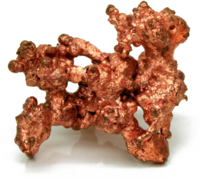Copper: Difference between revisions
Uncle Jesse (talk | contribs) (Change wikipedia link) |
Uncle Jesse (talk | contribs) m (Minor edits) |
||
| (2 intermediate revisions by the same user not shown) | |||
| Line 1: | Line 1: | ||
[[file:copper.png|thumb|200px|right|Copper]] | |||
From [https://en.wikipedia.org/wiki/Copper Wikipedia]: | From [https://en.wikipedia.org/wiki/Copper Wikipedia]: | ||
''Copper is a chemical element with symbol ''Cu'' (from Latin: ''cuprum'') and atomic number 29. It is a soft, malleable, and ductile metal with very high thermal and electrical conductivity. A freshly exposed surface of pure copper has a reddish-orange color. Copper is used as a conductor of heat and electricity, as a building material, and as a constituent of various metal alloys, such as sterling silver used in jewelry, cupronickel used to make marine hardware and coins, and constantan used in strain gauges and thermocouples for temperature measurement.'' | |||
For the purposes of [[ | ''Copper is one of the few metals that occur in nature in directly usable metallic form as opposed to needing extraction from an ore. This led to very early human use, from c. 8000 BC. It was the first metal to be smelted from its ore, c. 5000 BC, the first metal to be cast into a shape in a mold, c. 4000 BC and the first metal to be purposefully alloyed with another metal, tin, to create bronze, c. 3500 BC'' | ||
For the purposes of [[distillation]], copper is the preferred metal for [[still]]s, [[worm]]s and any metal in the vapor or distillate path. One advantage of copper is that it helps remove [[sulfites]] on contact which improves the quality of the [[Distillate]]. | |||
[[Category:Equipment]] | [[Category:Equipment]] | ||
[[Category:Glossary]] | [[Category:Glossary]] | ||
Latest revision as of 01:23, 8 October 2017
From Wikipedia:
Copper is a chemical element with symbol Cu (from Latin: cuprum) and atomic number 29. It is a soft, malleable, and ductile metal with very high thermal and electrical conductivity. A freshly exposed surface of pure copper has a reddish-orange color. Copper is used as a conductor of heat and electricity, as a building material, and as a constituent of various metal alloys, such as sterling silver used in jewelry, cupronickel used to make marine hardware and coins, and constantan used in strain gauges and thermocouples for temperature measurement.
Copper is one of the few metals that occur in nature in directly usable metallic form as opposed to needing extraction from an ore. This led to very early human use, from c. 8000 BC. It was the first metal to be smelted from its ore, c. 5000 BC, the first metal to be cast into a shape in a mold, c. 4000 BC and the first metal to be purposefully alloyed with another metal, tin, to create bronze, c. 3500 BC
For the purposes of distillation, copper is the preferred metal for stills, worms and any metal in the vapor or distillate path. One advantage of copper is that it helps remove sulfites on contact which improves the quality of the Distillate.
